With the new print system at Notre Dame, many students may be unsure how to print correctly. Instructions for printing can be found at http://oithelp.nd.edu/print/. The quota works as follows: each student starts with 1000 points, or roughly 500 sheets of paper worth of printing. A double-sided black and white (B&W) sheet costs two points, while a single-sided B&W sheet costs four points. A double-sided color sheet costs 12 points, while a single-sided color sheet costs 24 points. Most of you are probably wondering why it costs you double the amount of points to print a single-sided sheet. This policy seems to be ludicrous as it charges students twice the points for less printing.
In typical printing, the paper costs less than a penny per sheet, while the ink costs about one to two cents per page. These prices do not even account for bulk-purchase discounts or contracts with suppliers. According to Notre Dame's OIT page, the main goal of the dubbed "Duplex Printing Initiative" is to reduce printing for environmental reasons. That said, if students want to print, they are going to print.
Environmentally speaking, there is a strong reason to limit printing. According to International Paper: “Every day the forest products industry plants more than 1.7 million trees in the U.S. Today, there are 12 million more acres of forests in the U.S. than in 1987.” Clearly it is beneficial to use paper, as the companies who process trees plant just as much if not more than they take down. Wood is a renewable resource and should not be treated as a non-renewable one. In addition, there are recycling bins located in every building across campus, allowing for even more environmental consciousness and the reuse of paper when it is no longer needed for class.
Charging double for single-sided sheets will potentially reduce some use of paper if people switch to double-sided printing. On the other hand, the policy makes little sense for students who need to print a single page paper, reading, or article for a class. In this case they are penalized for printing less than two pages. In the same sense, students printing lengthier papers, readings, or articles are also being penalized by printing less than an even number of pages, while they are already using a large amount of points to print in the first place. While the policy may help reduce some printing, overall, it penalizes students unnecessarily. One way to reduce your personal printing is by printing two pages per one side. This can easily be done for PDF documents on either a Mac or PC. A way to not be penalized for these single-sided pages is to add a blank page to the PDF, making the total number of pages even.
Ultimately, there is little reason or evidence for why students should be charged more for single-sided printing. There is virtually no environmental benefit and students are being unjustly penalized. Truly, students will print whatever they want or need, so there really should be no quota in the first place. However, the quota is what we have, so make the best of it by adding blank pages to documents. Happy printing!













